Our interview with Giant Squid’s Creative Director, Matt Nava, about the studio’s latest title, Sword of the Sea has been edited for length and clarity.
Out of Summer Game Fest, Sword of the Sea had my heart. Developed by Giant Squid, the title comes from the creative mind behind Journey and Abzû, Creative Director Matt Nava. While it may be compared to those critically beloved titles, Sword of the Sea defines itself through its surfing mechanics, distinguishing it from the past and showcasing a bright future for Giant Squid.
We spoke with Matt Nava about the game’s development process, art, mechanics, and what he hopes players will take away from the game. The synopsis, in Nava’s introduction, was that it’s an atmospheric adventure game where you surf on a sword and you unveil a lost ocean in a mystical world that’s animated with moving waves. Sword of the Sea is very much that, a game that thrives in its simple surfing mechanics and brilliant world-building.
But as I spoke with the Creative Director about the game, he outlined how detailed every bit of the game was, finely tuned to push curiosity and ultimately to tackle a story about what happens when your fight is done. The former was the first question asked of Nava, explaining that despite the lack of HUD and a large open world, I was never frustrated. Instead, I was enticed to see the larger world.
“[Curiosity versus frustration] is something I think about a lot, actually, because I think that as game designers, we kind of default to punishing the player if they don’t do something right, because that’s just kind of how arcade games worked. [Games] made money when you lost, but that’s not the business model anymore. So, it’s more fun to do some positive reinforcement in video games,” Nava started.
Curiosity and movement are central to Sword of the Sea.
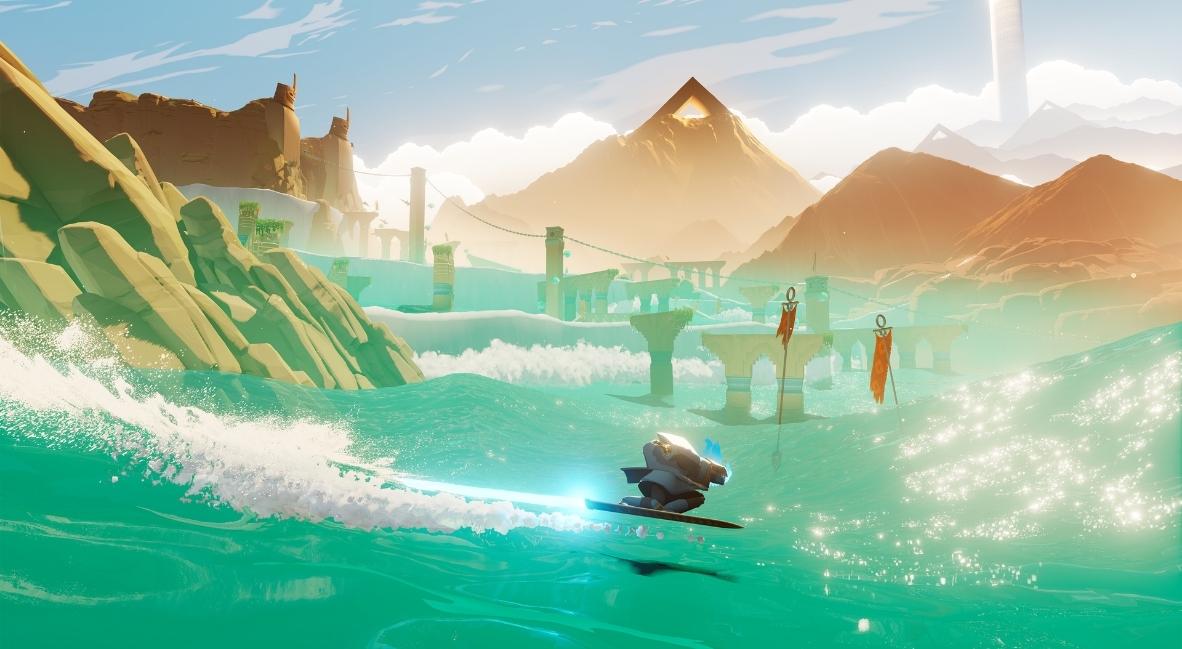
“We did a lot of work thinking about how not to fail you, how to let you play and learn, how to let you fall off things, but make it easy enough to save yourself from that mistake. That’s why the game has a triple jump. You could keep jumping because it’s okay, and we don’t really want this to be a platformer challenge game; we want this just to be fun because that’s what’s great about jumping in the game, right? What’s fun is just getting really high and going fast, and we want everybody to experience that, even if they’re not super experienced.”
He concluded, “We want you to become a pro surfer character and that was really the core to the design [for Sword of the Sea] from the beginning—to do everything we could to take our first instinct as designers, which is to always [say] okay, if they fail, then reset, game over, and just be like, ‘No, how do we approach that differently?’ and it shapes the whole experience [for the player].”
That open exploration is one of the most beautiful things that Sword of the Sea accomplishes. It somehow finds a balance between curiosity, challenge, and effortlessness when you’re surfing across wide-open dunes, only finding true structure as you navigate ruins. But exploration is one thing, also getting the dopamine hit of landing bigger and bigger jumps, catching larger air time, and gaining speed is all in the mechanics. And, Sword of the Sea wears its inspiration on its sleeves.
“I mean, big fan of the Tony Hawk games obviously, but also those old snowboarding games like 1080 Snowboarding on the N64. I grew up on that stuff!” Nava explained. “I just loved the movement in those games. You forget about the high score for a while, and you’re just moving, and it’s fun to do the tricks, [see] the cool animations, and in snowboarding ones, it also has this big emphasis on speed.”
“But those games were in very constrained worlds. It was like the warehouse, where you had to do tricks off the two ramps in here, or on the snowboarding games, you’re going downhill, you’re going down the same run [of] the mountain, and that isn’t the fault of those games because that’s actually important for how they work,” he said.
“We want you to become a pro surfer character and that was really the core to the design [for Sword of the Sea] from the beginning”

The comparison to those mechanics put a smile on Nava’s face, but the excitement he showed in explaining the differences was even more noticeable.
“I was interested to think what if you could have some of those ideas some of those feelings of speed the movement the animation and put it in a world where you could go uphill where you could go around, and explore which is something that we’ve been exploring how to build that kind of game in our previous work,” Matt Nava said. “It was a really cool natural extension of the ideas we’ve been thinking about and this kind of fun homage to these games that I loved as a kid, even Wave Race, just with the water physics.”
But when it comes to the games that Nava and I discussed, they had one thing in common, outside of just movement. They each have you repeat the same task and movements, but it never gets repetitive. Be it systems, environments, art, or soundtrack, they keep you invested instead of hitting that repetitiveness fatigue. To that comment, the Giant Squid Creative Director explained how he and his team approached design to elicit the same player loop.
“I think one thing that you have to design into these games that are all about movement is: How do you make it an engaging moment-to-moment?” Nava started, “Because in a racing game you’re thinking about every turn, and in Mario Kart it’s like okay, you got to figure out how to do the right drift, and you have to make sure you’re in the right place for the next one and that’s the moment to moment thing you’re thinking about. In [Sword of the Sea], it’s like an exploration game. There’s a landmark on the distant horizon. You’re holding forward, but what are you doing until you get there?”
He continued, “For us, the answer was to create these waves that are animating as you move. So all of a sudden, it’s not just a field of jumps, it’s like the jumps are moving, but you have to think about them. It’s not at the front of [your] mind, but it’s in the back of your head. You’re just constantly doing this subtle reaction to the world as it moves. And that makes it so that these jumps that you’re doing are always a little different, just enough to make it feel fresh and stay interesting as you make your way to the distant objectives in the game.”
Giant Squid continues to excel in developing players’ investment in the world with minimal bells and whistles.
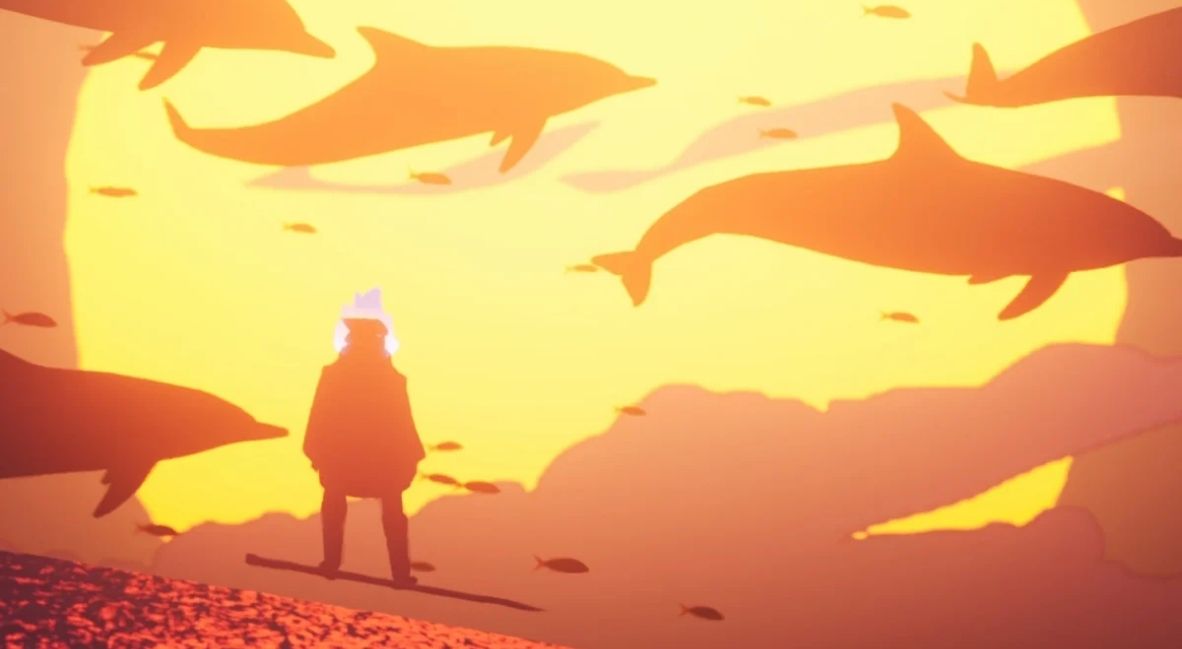
Like the waves, you don’t ever have to think too hard about what you’re doing in Sword of the Sea. This isn’t to say that you aren’t engaged, only that everything becomes natural. This is due in large part to mechanics, but to have the effortless tracking of the world and your movement, it also has to do with the subtle ways that the game tells you that you have progressed.
There is no map or HUD to help you find your way, but the game’s shifting art style as you bring water back to the lands becomes one significant way to breadcrumb where you have been. Which is essential if you’re a completionist in exploration games like I am.
When asked about how Giant Squid approached navigation with no menus, Nava answered, “The big thing was that [Sword of the Sea] starts as a desert and then as you make your way through, you transform areas into water, and it literally goes from sandy [orange] to glistening emerald greens and blues, these super popping colors. At first, I just had this idea of the waves, and I had been to the dunes and Pismo Beach, and what’s really cool about that is that there are these big sand dunes. It looks like the Sahara Desert here in California, and it’s really unexpected, and right on the ocean [too].”
He continued, painting a picture, “You’re looking at the water, these waves that are moving, and then there are these giant sand waves that are moving just at another time scale. [The waves] move slowly and stuff, and you can’t help but imagine the waves of sand moving the waves of the water. And so I had that parallel, and I was like, ‘Okay, let’s play with this.’ We figured out that when you change [the landscapes], it’s like a breadcrumb trail.”
“You can all of a sudden [see], ‘I’ve been there.’ And then you don’t really need a map, which was another thing that we had been exploring in our previous game, The Pathless, which was like an open-world game that didn’t have a map. [Sword of the Sea] was like, here’s a way for the world state to reveal itself to you very clearly, and very intuitively in the graphics of the world itself. You don’t need an overlay. You don’t need to pause and look at a map, which keeps you immersed in the game’s atmosphere. But we discovered all these ways to take advantage of that,” Nava said.
As I was about to move the conversation to a different topic, Nava had one more thing to add. “There is another subtle [feature], you go a little faster on water. We make it so that when you’re in water, you speed up. It’s not a dramatic increase, but it’s enough where you can subtly feel it. What’s great about that is that it reinforces that the water is fun. You want to see more water. You want to go fast.”
Pulling the thought back toward exploration, he ended, “It also makes it so that if you’re backtracking and you’re in the area you’ve already been to, and you’re like, ‘Okay, I’m ready to continue,’ you can get out of there quicker, right? Because you’re able to go fast. [This gives] you more agency as a player, the more you complete the level. That was a fun little game design aspect of the game.”
The water you bring back to the world is a character all of its own in Sword of the Sea.

The landscape changing is the most gorgeous experience of the game, and the whale that you can surf is a showstopper in the reveal trailer. But with such a large world, I had to ask Nava about how the development team approached the complete change in aesthetic and made it feel natural. But more importantly, it balanced the joy that both sand and water can bring to a player in the game loop.
“We had this idea of changing into the ocean and bringing life back. There was actually quite a long time [in development] when people liked it better when it was sand, and they were like, ‘It’s water now. It’s no fun.’ Or it was the opposite for a while, too. It was like, ‘The water is great. The sand is terrible.’ It was really hard to make it so that it was satisfying to me in [both landscapes]. We worked hard to make sure that the game is just as much fun in [both] states,” Matt Nava explained.
He continued, “But the creatures are a big part of that too, and I think it’s really satisfying to see these animals reappear, and it makes [the game] feel less lonely. The fish and the whales, they’re kind of like, if the ocean were a character, this would be the character. They’re an extension of the ocean as a character in the game. It feels like the ocean is kind of now playing with you, and in the game, you can ride on the whale, and it’s just super satisfying.”
“In game design, you’re always talking about ‘how do you reward the player,’ and you can do it in these kinds of ways. Lots of games have currency and money, and you can get abilities—and we have some very light stuff like that in [Sword of the Sea], which makes it fun to explore—but I think the more satisfying reward is the intrinsic satisfaction of a really great interaction in the game. It’s just awesome to ride on the whale, and you don’t get points, whatever. It’s just fun, and at the end of the game, that’s really what you take away,” he explained.
“You don’t think, man, collecting all the coins in Mario was great. It was like coins were there to make you jump, and jumping was great. [Here], you remember the whale. So that’s what we try to remember, and fill the game with stuff like that, so that all those little game mechanics are there to help you have memorable moments. And the whale is just a great moment,” Nava ended.
“All the current events got me thinking about what happens at the end of all this, what happens when all the wars are fought and all the wars are done? What’s the sword for? What do you do with them, and what’s your identity after all that stuff?”

Another element that stands out in Sword of the Sea’s environment is its architecture. When asked about the inspiration for the ruins of the world, Matt Nava excitedly answered, “I’m a huge architecture nerd. I love ancient architecture. In [Sword of the Sea], there’s a lot of inspiration from Romanesque and Italian Renaissance architecture, as well as French architecture. But we also have a ton of other [influences]. There are Egyptian-inspired glyphs, and there are Islamic Muqarna-inspired [buildings too]. What I love to do is create a blend. It’s not trying to be one place on earth. It’s not [even] trying to be Earth.”
He continued, “It’s trying to be something familiar to someone from Earth, but it’s also trying to take you somewhere new. And I think the benefit of that is that it helps you see our world with a new perspective, and it also makes the game for everybody. There’s something from that that’s an appreciation of many cultures and the beauty that they all have. And so, I think it’s just fun to combine them and see the similarities because they all come from the same place in our mind, they all come from a human design mindset.”
Circling back to one of our early questions about exploring the world without a map, Nava added, “Architecture in video games is just fascinating because it works very similarly to the way architecture works in real life, which is that it shapes your experience. [Video Game architecture] literally puts boundaries on where you can and can’t go. You don’t think ‘I’m going to go that way’ because there’s a wall there, right? But if there wasn’t a wall there, you would think I could go that way.
He added, “Game design is creating the environment. You don’t have control of what the player is going to do moment to moment, but you do have control of where they’re going to be. And then you have to design that architecture in a way that they’re most likely to have the thought you want them to have, so the architecture is a really fun combination of kind of the visual artistry and the design, and also a very powerful game design tool for creating an experience.”
Sword of the Sea’s environment guides you and rewards you for exploring at your own pace.
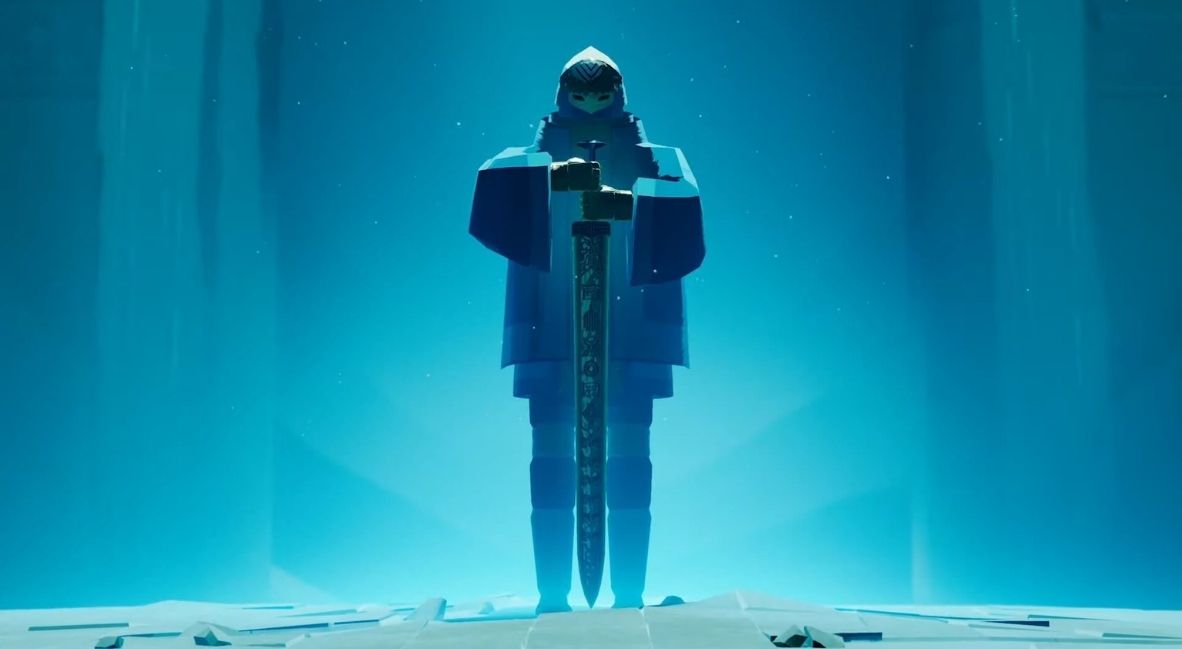
As our conversation was winding down, there was one element of Sword of the Sea that we hadn’t touched yet: story. As the Wraith, the game’s character, you surf on your sword, rebuilding the desolate land of a necropolis in ruins. As Matt Nava said earlier, you’re bringing life back to a land. And right now, with all of the climate crises happening, the game’s message feels like a ray of hope in a pretty bleak future.
For me, playing the game has been a joyous experience, but also, more specifically, it’s been relaxing in a way that hasn’t detached me from the world around me. Instead, it gave me hope about it, even if it was only while I was surfing on the dunes. As I explained this to Matt Nava, he thanked me for my perspective and then explained how the story’s message and the game itself highlight what the creative process is like for him.
“I think that this really gets to kind of a deep thing I think about as a creative person and making a video game: ‘Why am I doing this?'” Nava started. “To me, you try to leave the world better than you came into it, and you try to give people something meaningful and worth their time, and a message. Video games are really special in that regard because people play them, and they get different things from them. You might play this game and be like ‘Wow, it was a great surfing game’ and that’s cool.”
He continued, “Or you might think about it deeper, and you might get something more. You might play it longer. You might have a deeper connection. And we really wanted to make it so that no matter how deep you go into this game, you come out with something that is worthwhile. [For] the Wraith and his story, you’re riding on a sword, but you’re not using it to fight.”
“[This mechanic] plays on these preconceptions of what a video game character is. It’s usually like, this character’s got a sword, and it’s just normal for video games that swords are tools of death. And that’s fine, but that’s weird,” Nava leans in slightly, explaining his thought process behind the Wraith, and not putting combat into Sword of the Sea.”We kind of start with that assumption [as the Wraith, that], ‘I’m a sword guy.’ And then you start surfing, and you don’t even think about it.”
“You’re still in the process of suspending disbelief at the beginning of the game, and then later you’re like, ‘Wait a minute, why am I riding on a sword? What’s up with that?’ I hope that it starts to make you think, because I believe that all the current events got me thinking about what happens at the end of all this, what happens when all the wars are fought and all the wars are done?
“What’s the sword for? What do you do with them, and what’s your identity after all that? I think that’s the kind of question the game is trying to explore. The character is this warrior, and now he’s got to do something new because there’s nobody to fight anymore. So what do you do? Go surf.”
“[Sword of the Sea] is not just my game. It’s this entire team of fantastic developers that I work with [at Giant Squid], and they’ve all put their heart and soul into it. It’s the thing beyond me in a way.”

With Sword of the Sea comes the ability to learn a lot about yourself, especially when your first video game succeeded the way that Matt Nava’s debut title did. About what he learned throughout the development process, Nava said, “I think that a lot of these things just come intuitively to you, all my games you can see a kind of through line, and it’s hard to explain. But after people played Journey, then they played Abzû, and they’d say, ‘I feel like this is the Journey guy.’ I don’t know, they could just feel it.”
“Even though [Abzû] is an underwater game, and Journey is a dry desert game, there’s just something in those games that is the same, and it was me. Every time I make a new game, I think about the old one and wonder: How did that go? What could I do differently? What would I like to do now?” Nava paused for a second, “How can I do something interesting that builds on what I did but also takes it in a new direction because I don’t just want to do the same thing again, especially after Journey?”
“[Journey] was one of the first games I worked on, and it was just a phenomenon out of nowhere. People love that game, and it got game of the year awards. It was just a very surprising thing. All of a sudden, you have the dilemma of ‘Okay, can I do another game?’ This was the first time I’ve done a game with the desert, and I believe that when I was like, what, I’m going to use the orange color in a video game, [for Sword of the Sea]. What a concept!”
As a critic, it’s easy to look to the past to describe what you’re currently playing. Sometimes, as a frame of reference for a player, and others, because of similar mechanics. Comparisons are inevitable. But at the same time, the vulnerability that comparison pushes on developers can’t be understated. And that was top of mind for Matt Nava.
“It was really challenging for me to do that because I knew that what it would do is immediately make people say this is like Journey, and then I’m asking to be compared to my old work. You make yourself vulnerable in a way. But [Sword of the Sea] is not just my game. It’s this entire team of fantastic developers that I work with [at Giant Squid], and they’ve all put their heart and soul into it. It’s the thing beyond me in a way. And I think that’s what I’ve learned, to a large degree, on this project. [I learned] that it’s okay to be who you are, you just have to do what’s in you.”

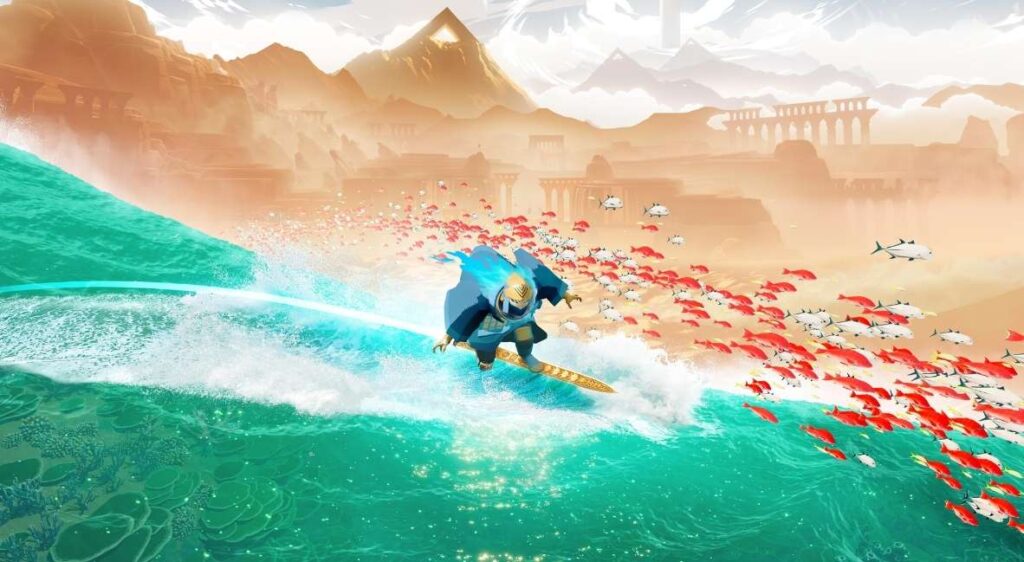

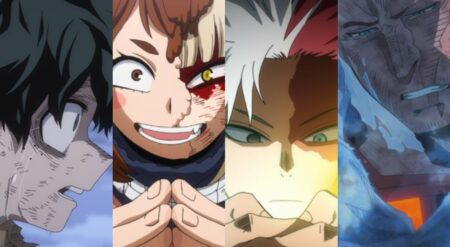
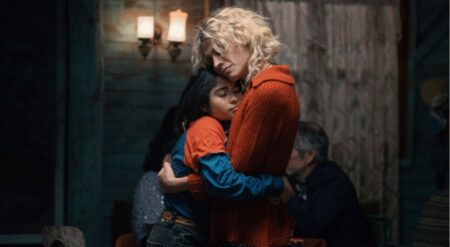

![[EXCLUSIVE] ‘Invincible VS’ Devs Dive Deep Into Their New Original Character: Ella Mental Ella Mental in Invincible VS](https://butwhytho.net/wp-content/uploads/2025/12/Invincible-VS-Ella-Mental-But-Why-Tho-1-450x247.jpg)
![[EXCLUSIVE] Palia Devs Dive Into Winterlights, New Tints, Lunar Paths, And More From Upcoming Patch Palia Winterlights Patch](https://butwhytho.net/wp-content/uploads/2025/12/Palia-Winterlights-But-Why-Tho-450x247.jpg)